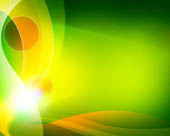
Purpose
To extract the hidden colors that makes up the main colors of various felt-tipped markers.
Additional information
Have you ever used a marker and thought to yourself "I wonder what colors have been combined to make the color I'm using?" Well... neither have we, but we thought it would make for a fun experiment to find out! We'll have a little fun by finding out exactly what colors have been combined to make the colors of various markers.
Sponsored Links
Required materials
- Several felt-tipped markers of various colors. Make sure the markers are washable water-based markers, not permanent ones (no Sharpies)
- Coffee filter paper (dry)
- Short drinking glass
- Water
- Scissors
- Ruler
Estimated Experiment Time
Less than 15 minutes
Step-By-Step Procedure
- 1. Add about 1/2 inch of water to the bottom of the glass. Use your ruler to get the approximate level by pouring some water in the glass and measuring it by placing the ruler into the water.
- 2. Cut the coffee filter paper in long strips, about an inch wide. Cut as many coffee filter strips as you have markers. For example, if you have five colored markers, cut five separate strips of coffee filter paper. Each strip should be about the length of the glass.
- 3. Take one of the strips and color a dot about 1 inch from the bottom of it. Use your ruler to find the exact position to color the dot.
- 4. Gently place your strip into the water glass, leaning the strip along the edge of the glass (so it's at a slight angle). Ensure the water level is below the colored dot!
- 5. Wait a few seconds and the water should start to rise up the coffee filter strip. What can you observe is happening?
- 6. As the water starts to carry up the filter it will pass the dot. As it passes the dot, the ink from the dot will be carried upward. As it's carried upward, the ink will separate into its various colors.
- 7. Repeat the process for your remaining markers and strips to see what colors the dots will be made up of.
Note
This experiment won't work with all markers. For example, Sharpies and other permanent markers won't work. You'll need to use water-based markers, such as dry-erase markers or washable branded markers.
Observation
Why do you think Sharpies and other permanent markers won't work with this experiment? When you conducted this experiment with your markers, did all of them expand and streak into various colors? If not, what does that tell you about the composition of the markers?
Result
Most inks are actually mixtures of several different colors. As the water absorbs, it carries the ink up through the filter paper. The colors separate out because some colors move further and faster than others. When the paper dries you'll be left with streaks of varying colors from the original dot that you colored on the paper.
Sponsored Links
Take a moment to visit our table of Periodic Elements page where you can get an in-depth view of all the elements,
complete with the industry first side-by-side element comparisons!